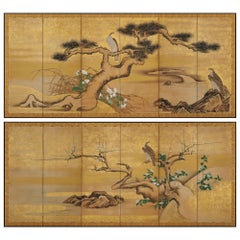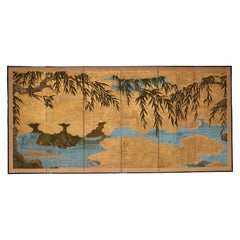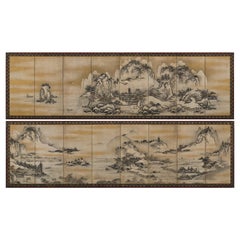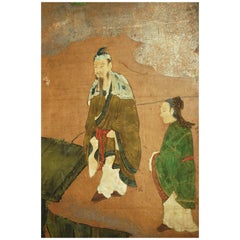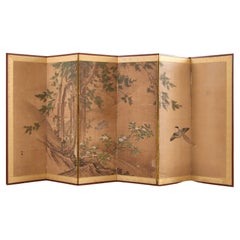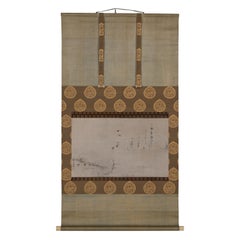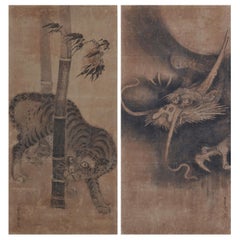Mid-17th Century Paintings and Screens
to
4
175
690
922
151
321
197
108
38
4
34
14
12
24
31
26
28
8
4
2
2
2
1
4
4
4
4
4
4
Period: Mid-17th Century
17th Century Japanese Screen Pair by Soga Nichokuan, Hawks on Pine & Plum Trees
Located in Kyoto, JP
Hawks on plum and pine
Soga Nichokuan (active circa 1625-1660)
Pair of six-fold screens.
Ink, mineral pigments, gofun, gold and speckled gold l...
Category
Japanese Edo Antique Mid-17th Century Paintings and Screens
Materials
Wood, Paper
Japanese antique screen - EDO period - Willow over a stream
Located in Prahran, Victoria
Antique Japanese 6 panel screen from the early Edo period (C1650). One of a pair (both available). This magnificent golden screen shows...
Category
Japanese Edo Antique Mid-17th Century Paintings and Screens
Materials
Gold Leaf
17th Century Japanese Screen Pair. Tiger & Dragon by Kaiho Yusetsu
Located in Kyoto, JP
Kaiho Yusetsu (1598-1677)
Tiger and Dragon
Early Edo Period, Circa 1650
A Pair of Six-fold Japanese Screens. Ink and slight color on paper.
Dimensions:
Each screen: H. 171 cm x W. 380 cm (67.5’’ x 149.5’’)
In this pair of early Edo period Japanese screens a group of tigers prowl in a bamboo grove whipped with fierce wind, while a dragon claws through clouds and mist. The dragon embodies elemental qualities - looming out of the mist, the coils of its body disappearing in the clouds. The dragon is calling for rain, symbolizing spring which is considered the fountain of life. On the other side, the tigers calls for the wind, symbolizing autumn which is considered the end of life. Tigers were familiar motifs within Japanese art from ancient times though the animals were imaginary to the people in the 17th century. While dragons and tigers are usually associated as sacred and ferocious, in this painting, both animals have rather amusing expressions. The tigers appear to glare at the dragon with cat-like eyes, and the look on the swirling dragon’s face appears almost affectionate - lending a playful flair to an otherwise magnificent theme.
The tiger and dragon are cosmological symbols of the balancing forces in the world. Screens such as this were originally meant to express the fluctuating nature of the world. For Japanese in the early Edo period, they likely suggested the powers of the cosmos. In Japan the tiger and dragon motif was originally absorbed into the circles of Zen monasteries before spreading into the secular world. The theme especially appealed to the military classes with the Kano school, the official painters to the Shogun and the samurai, being the leading contributors. The painter of this pair of screens, Kaiho Yusetsu (1598-1677), was closely patronized by the third Shogun Tokugawa Iemitsu. In his later years he worked with Kano school artists...
Category
Japanese Edo Antique Mid-17th Century Paintings and Screens
Materials
Silk, Wood, Paper
17th Century Japanese Screen. View of West Lake by Unkoku Toyo.
Located in Kyoto, JP
Unkoku Toyo (1612-1668)
View of West Lake
Pair of eight-panel Japanese Screens. Ink and gold wash on paper.
Dimensions: Each screen: H. 110 cm x W. 372 cm (43” x 147”)
This pair ...
Category
Japanese Edo Antique Mid-17th Century Paintings and Screens
Materials
Paper
Related Items
18th Century Japanese Kano School Landscape Screen
Located in Prahran, Victoria
Japanese Kano school screen with pine tree, camellias, cherry blossom and Chinese figures in the landscape, circa 18th century.
Materials: Pigmen...
Category
Japanese Antique Mid-17th Century Paintings and Screens
Materials
Silver Leaf
19th Century Japanese Edo Six Panel Kano School Landscape Screen
Located in Rio Vista, CA
Late Edo period 19th century Japanese six-panel landscape screen featuring a cypress tree over a flowering hibiscus with a pair of hototogisu birds. Kano school painted with ink and ...
Category
Japanese Edo Antique Mid-17th Century Paintings and Screens
Materials
Silk, Wood, Paper
Japanese Showa Two Panel Screen Blossoming Prunus Tree
Located in Rio Vista, CA
Serene Japanese Showa period two-panel folding byobu screen depicting a large spring blossoming prunus tree or plum tree. Beautifully painted with ink and natural color pigments on m...
Category
Japanese Showa Mid-17th Century Paintings and Screens
Materials
Brass
Japanese Edo Four Panel Screen Flowering White Chrysanthemums
Located in Rio Vista, CA
19th century extraordinary Japanese late Edo/early Meiji period four-panel byobu screen featuring flowering white chrysanthemums painted in a moriage (raised pigment) style. The pain...
Category
Japanese Edo Antique Mid-17th Century Paintings and Screens
Materials
Brass, Gold Leaf
Antique Japanese Suibokuga Egrets by Kano Tokinobu, 17th century.
Located in Point Richmond, CA
Antique Japanese Suibokuga Egrets by Kano Tokinobu, 17th century.
A sumi-e ink on paper painting illustrating two egrets in reserve with no outlines contrasting with the reeds from the marsh in the background. The painting with 3 vermillion seals of the artist in the lower left corner. Japanese dry mount paper on a wood frame with thin brocade border silver leafed surround and lacquered wood outer frame.
Condition: Lighter discoloration on the lower portion of the painting, other minor signs of age, wear, stains and repairs otherwise fine condition.
Age: Painting Edo Period, circa 1670. Mounting circa 1985.
Image: 51-1/2 in. x 20-1/2 in. (131cm x 52cm)
Frame 59-1/4 in. x 25-1/4 in. (150cm x 64cm)
Weight: 6 lbs.
Provenance:
with Honeychurch Antiques...
Category
Japanese Edo Antique Mid-17th Century Paintings and Screens
Materials
Paper
Edo Period (19th) Japanese antique painting of flowers
Located in Fukuoka, JP
Japanese antique painting of flowers 19 C
Weight 3kg ( 6.6lb)
Category
Japanese Edo Antique Mid-17th Century Paintings and Screens
Materials
Silk, Paper
Japanese Edo Six Panel Screen Flowering Morning Glory
Located in Rio Vista, CA
Spectacular 19th century late edo period six panel byobu screen featuring flowering morning glory vines (as-agao). Machi-eshi or anonymous town artist painter crafted in an amalgamat...
Category
Japanese Edo Antique Mid-17th Century Paintings and Screens
Materials
Brass
Japanese Edo Period Six Panel Screen of Chinese Scholars
Located in Rio Vista, CA
Fascinating 19th century Japanese late Edo period six pane funpon screen. Large scale depicting Chinese scholars and officials engaged in leis...
Category
Japanese Edo Antique Mid-17th Century Paintings and Screens
Materials
Silk, Wood, Paper
Antique Japanese Suibokuga Landscape by Kano Tokinobu, 17th century.
Located in Point Richmond, CA
Antique Japanese Suibokuga Landscape by Kano Tokinobu, 17th century. A sumi-e ink on paper painting illustrating a rocky seaside landscape containing buildings, vegetation and ship masts. The painting with 3 vermillion seals of the artist in the lower left corner. Japanese dry mount paper on a wood frame with thin brocade border silver leafed surround and lacquered wood outer frame.
Condition: Lighter discoloration near the bottom of the painting, various paper restorations, other minor signs of age, wear, stains, otherwise fine condition.
Age: Painting Edo Period, circa 1670. Mounting circa 1985.
Image: 51-1/2 in. x 20-1/2 in. (131cm x 52cm)
Frame: 59-1/4 in. x 25-1/4 in. (150cm x 64cm)
Weight: 6 lbs.
Provenance:
with Honeychurch Antiques...
Category
Japanese Edo Antique Mid-17th Century Paintings and Screens
Materials
Paper
Japanese Two-Panel Screen Ink Painting of Palm Trees on Paper
Located in Hudson, NY
Japanese two-panel screen: ink painting of Palm Trees on paper, Edo period (1787) beautiful painting of Japanese windmill palm trees. Ink paint...
Category
Japanese Edo Antique Mid-17th Century Paintings and Screens
Materials
Silk, Wood, Paper
Antique Japanese Suibokuga Sage by Kano Tokinobu, 17th century.
Located in Point Richmond, CA
Antique Japanese Suibokuga Sage Painting by Kano Tokinobu, 17th century. A sumi-e ink on paper painting illustrating an acolyte at a riverbank. The image of the standing Chinese figure with elongated earlobes (a symbol of enlightenment), hair tied back in a kerchief and long beard, holds a large fan in his left hand to his right shoulder. The long robes are windswept with water curls about the figures feet. The painting with 3 vermillion seals of the artist in the lower left corner. Japanese dry mount paper on a wood frame with thin brocade border silver leafed surround and lacquered wood outer frame.
Condition: Paper restoration on center, a quarter of an inch of the left edge of the painting is added, other minor signs of age, wear, stains and repairs overall fine condition.
Age: Painting Edo Period, circa 1670. Mounting circa 1985.
Image: 51-1/2 in. x 20-1/2 in. (131cm x 52cm)
Frame: 59-1/4 in. x 25-1/4 in. (150cm x 64cm)
Weight: 6lbs.
Provenance:
with Honeychurch Antiques...
Category
Japanese Edo Antique Mid-17th Century Paintings and Screens
Materials
Paper
17th Century Japanese Edo Four Panel Screen Hotei with Chinese Sages
Located in Rio Vista, CA
Beautifully weathered late 17th/early 18th century Japanese edo period four panel byobu screen depicting hotei (fat monk) in a treed landscape with Chinese sages engaged in leisurely...
Category
Japanese Edo Antique Mid-17th Century Paintings and Screens
Materials
Brass
Previously Available Items
17th Century Japanese Scroll Painting. Plovers in Moonlight by Kano Ujinobu
Located in Kyoto, JP
Plovers in Moonlight
Kano Ujinobu (1616-1669)
Mid 17th century
Ink and gofun on paper
A mid 17th century Japanese scroll painting by the Kano school artist...
Category
Japanese Edo Antique Mid-17th Century Paintings and Screens
Materials
Paper
H 49 in W 26 in D 0.75 in
Japanese Scroll Painting, 17th Century Tiger & Dragon Pair by Soga Nichokuan
Located in Kyoto, JP
Tiger and Dragon
Soga Nichokuan (active, circa 1625-1660)
Pair of hanging scrolls, ink on paper.
Dimensions:
Each scroll 118 cm x 57 cm.
...
Category
Japanese Edo Antique Mid-17th Century Paintings and Screens
Materials
Paper
Antique Japanese Dragon Screen Attributed to Kano Tanyu, circa 17th Century
By Kano Tan'yu 1
Located in Prahran, Victoria
Japanese six-panel Kano School screen with a boldly painted depiction of a writhing dragon, rendered in ink on paper. Attributed to Kano Tanyu (1602-1674), 17th century signed and sealed.
Dimensions: H 173 cm x W 370 cm.
Here the dragon emerges from the swirling cosmic dust of the universe. The dragon represents yang, which encompasses light, the sun, the heavens, active forces and masculine forces.
Originally one of a pair, the other being a tiger, together the dragon and tiger are celestial companions and represent both the cosmic and earthly powers of this world. Together they symbolize the duality of the universe - the yin and yang. The tiger represents darkness, the moon, and the earth and feminine forces.
Kano Tan'yu (1602-1674) was one of the foremost Japanese painters of the Kano school. Originally named Morinobu, he was the eldest son of Kano Takanobu and grandson of Kano Eitoku...
Category
Japanese Edo Antique Mid-17th Century Paintings and Screens
Materials
Paper
H 68.12 in W 145.67 in D 0.99 in
